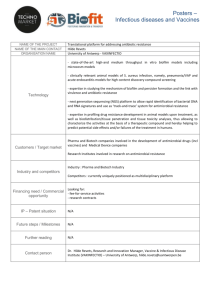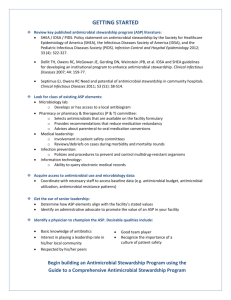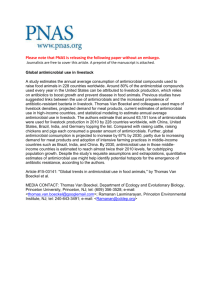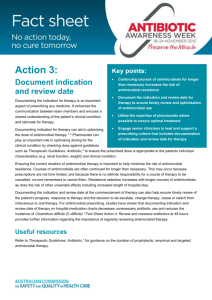- D
advertisement
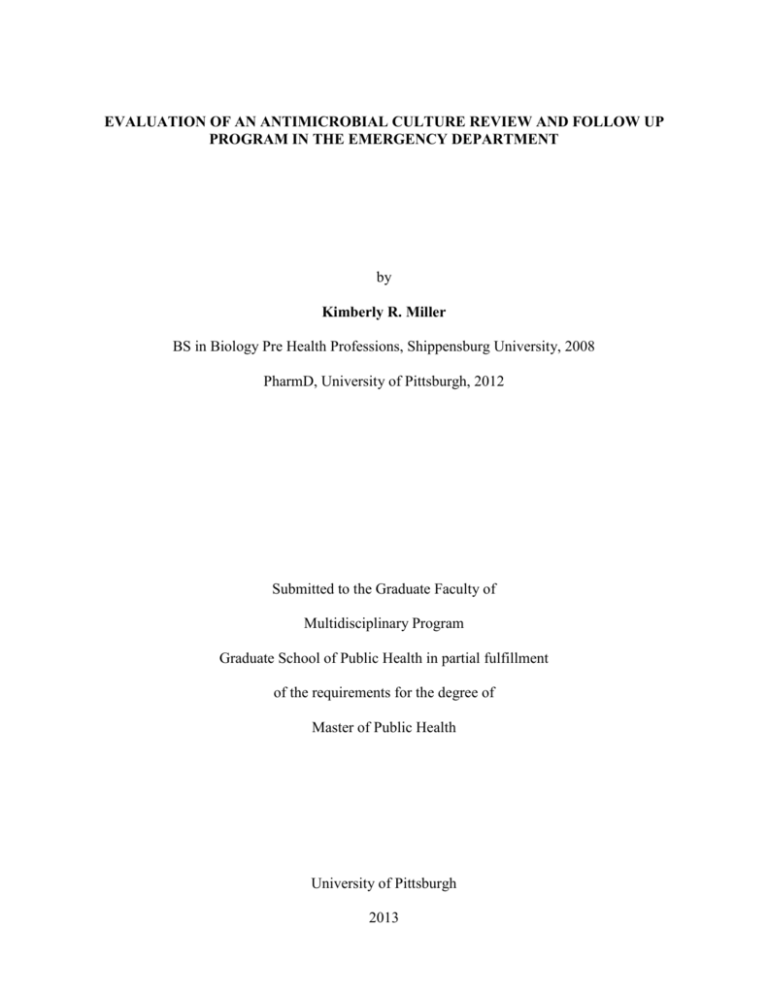
EVALUATION OF AN ANTIMICROBIAL CULTURE REVIEW AND FOLLOW UP PROGRAM IN THE EMERGENCY DEPARTMENT by Kimberly R. Miller BS in Biology Pre Health Professions, Shippensburg University, 2008 PharmD, University of Pittsburgh, 2012 Submitted to the Graduate Faculty of Multidisciplinary Program Graduate School of Public Health in partial fulfillment of the requirements for the degree of Master of Public Health University of Pittsburgh 2013 1 UNIVERSITY OF PITTSBURGH GRADUATE SCHOOL OF PUBLIC HEALTH This essay is submitted by Kimberly R. Miller on December 2, 2013 and approved by Essay Advisor: David Finegold, MD Multidisciplinary MPH Program Director University of Pittsburgh Graduate School of Public Health Essay Reader: Nicholas Castle, PhD, MHA Health Policy and Management University of Pittsburgh Graduate School of Public Health ______________________________________ ______________________________________ ii Copyright © by Kimberly R. Miller 2013 iii David Finegold, MD EVALUATION OF AN ANTIMICROBIAL CULTURE REVIEW AND FOLLOW UP PROGRAM IN THE EMERGENCY DEPARTMENT Kimberly R. Miller, MPH University of Pittsburgh, 2013 ABSTRACT Despite rising concern about antimicrobial resistance, there is limited information on the appropriateness of antimicrobial prescriptions in patients who are discharged from the emergency department (ED). Lack of antimicrobial stewardship and appropriate follow up is a public health concern due to inappropriate prescribing of antibiotics resulting in microbial resistance and inadequately treated patients potentially spreading infectious diseases. Our objectives were to describe the prevalence of inappropriate antimicrobial follow up prescriptions, based on Infectious Diseases Society of America (IDSA) or clinical guidelines, in discharged adult ED patients. These patients required follow up due to inadequate antimicrobial prescription and identify clinical factors associated with such prescription. iv TABLE OF CONTENTS PREFACE ................................................................................................................................... viii 1.0 INTRODUCTION ........................................................................................................ 1 2.0 METHODS.................................................................................................................... 5 3.0 RESULTS ..................................................................................................................... 7 4.0 CONCLUSION........................................................................................................... 10 APPENDIX A: DRUG INTERACTIONS ................................................................................ 12 APPENDIX B: ANTIOBIOTIC RENAL AND LIVER FUNCTION ADJUSTMENT ....... 15 APPENDIX C: STUDY DEFINITIONS ................................................................................. 158 BIBLIOGRAPHY ....................................................................................................................... 19 v LIST OF TABLES Table 1: Patient Characteristics Associated with Inappropriate Follow up .................................... 9 Table 2: Renal Adjustment (Micromedex-Version 1.39) ............................................................. 15 Table 3: Liver Adjustment (Micromedex-Version 1.39) .............................................................. 17 vi LIST OF FIGURES Figure 1. Appropriate Patient Follow up Based on Levels ............................................................. 8 vii PREFACE I would like to acknowledge Alyssa Tomsey, DO, Gajanan G. Hegde, PhD, Jennifer Shang, PhD, John O’Neill, MD, Arvind Venkat, MD, and Molly McGraw, PharmD, whose assistance and encouragement made this research possible. viii 1.0 INTRODUCTION With an increasing prevalence of multi-drug resistant organisms in both the hospital and community setting, appropriate antibiotic treatment and follow up is becoming increasingly important. This rise in multi-drug resistant organisms have been associated with increased mortality, morbidity, and costs to both the patient and health care systems.1,2 According to the Infectious Disease Society of America (IDSA) antimicrobial stewardship is defined as the coordinated interventions to measure and improve appropriate use of antimicrobial medications through the selection of optimal drug regimens, dose, duration, and route of therapy. This process includes achieving optimal clinical outcomes, while minimizing costs, adverse events, toxicities, and limiting the development of microbial resistance. While many health care systems have developed antimicrobial stewardship programs for patients that are admitted to the hospital, little data and evaluation exist on current practices of antimicrobial stewardship activities, including culture review and follow up with patients discharged from the emergency department (ED). Delays in patient treatment with appropriate antibiotics can lead to an increase in morbidity and mortality in patients and an increase in possible secondary infections. While this has not been well documented in patients that have been discharged from the emergency department evidence from the inpatient setting supports that these delays are associated with negative patient outcomes such as disease severity and development of a secondary infection.3-5 Appropriate dosing of an antibiotic can be almost as important as selecting the appropriate antibiotic regimen. Dosing of antibiotic medications can be dependent on many factors including, but not limited to, the type of infection, the severity of infection, and patient specific factors. Patient specific 1 factors can include renal function, liver function, concomitant medications, or other comorbidities. Patient’s allergies should also be taken into consideration when prescribing antibiotics and when overlooked can lead to secondary health issues, treatment failure, or even death.6-8 Preventable adverse drug events are still common within the health care system and while the estimates range greatly, have been estimated to be near 1.5 million a year in the United States. 6 It is well known that these medication errors can lead to increased length of stay in the hospital, unnecessary tests and treatment, and potentially death.7,8Common preventable adverse drug events consist of incorrect dose and prescribing a medication to a patient with a known allergy.6 In high volume and fast-pace situations, such as an Emergency Department, follow up with patients can be difficult. Many times these patients are transferred to other facilities or are discharged home before culture results are available. Follow up with these patients to ensure that they received appropriate antimicrobial therapy involves a complex system where patients have to be identified and then followed until their culture is available for review. Often times this culture review process can be difficult for Emergency Department physician and nursing staff to perform as it can impede daily workflow leading to multiple daily interruptions throughout the day. Pharmacists can play a vital role in a culture review and follow up process as they are equipped with the knowledge and expertise of appropriate antimicrobial selection and dosing and drug interactions. Several institutions have implemented a pharmacist-managed culture review program in the Emergency Department setting but data is limited with regard to its impact on patient outcomes. One retrospective study comparing physician-managed culture follow up program to a pharmacist-managed program showed that the total number of antibiotic adjustments was similar between groups (12% vs. 15%). However this study did display a decrease in the rate of unplanned readmissions for the same chief complaint within 96 hours in the pharmacist-managed culture follow up group compared to the physician-managed program (19% vs. 7%) (p<0.001).9 Possible reasons for unplanned readmission included antibiotic treatment failure, noncompliance due to cost, noncompliance not related to cost, allergy to prescribed medication, or adverse drug reaction.9This study supports the evaluation of Emergency Department culture review and 2 follow up programs for possible areas of improvement, including appropriate antibiotic selection and avoidance of potential adverse drug events. The current culture review and follow up process implemented in the Emergency Department at Allegheny General Hospital is primarily managed by registered nurses. The nurses review all patient charts from the previous day. Using these charts, the nurses note which patients had a microbiology culture obtained in the emergency department and will require a culture review and possible follow up. Using the current computer system, lists are created of these patients, noting the type of culture that is pending results. Once the culture results are available, the nurse compares the culture sensitivities to the antimicrobial regimen prescribed upon discharge from the emergency department or in cases where no antibiotic is prescribed, notes the presence or absence of an organism. The nurse then determines if further follow up is required on each microbial culture depending on the initial antimicrobial given to the patient, the presence of an organism, and sensitivities of the organism. If it is determined that further follow up with the patient is not required, the patient is removed from the computer list. If follow up with the patient is required, the nurse consults with the emergency medicine physician on staff in the department. The nurse approaches the physician with culture results, sensitivities, and suggestions for appropriate antimicrobial treatment. The physician then decides the appropriate antimicrobial therapy and the nurse follows up with the patient. This follow up includes communication with the patient and calling in a new prescription. The rationale of this research project is to determine whether there are opportunities for improvement on the existing antimicrobial culture review and follow up program in the emergency department with regard to antibiotic selection, dosing, duration, and potential for adverse drug reactions related to drug-disease and drug-drug interactions. The possible benefits of this program could include a more timely culture review and patient follow up process, an increase in appropriate selection and dosing of antimicrobial therapy, a decrease in antibiotic resistance emergence, a decrease in the length of stay of patients who are transferred to another health care facility, a decrease in health care system resource utilization and a decrease in unplanned Emergency Department readmissions within 96 hours for the same 3 chief complaint. This research has the potential to support the implementation of a pharmacist-managed antimicrobial culture review program. 4 2.0 METHODS A retrospective, observational cohort analysis of discharged adult ED visits with antimicrobial cultures at a single, tertiary care center (census: 50,000) (5/1-10/31/12) was performed. Microbial cultures were identified through the electronic health record (Sunrise) as being negative or positive and requiring follow up. Two independent abstractors (An emergency department physician and a pharmacist) determined the prevalence of visits with inadequate discharge antimicrobial prescription based either on organism susceptibility result or lack of prescription requiring patient call back for a positive culture. Paper charts were reviewed to determine whether appropriate follow up was performed on patients who did not have initial appropriate coverage. Inclusion criteria included patients who presented to the Allegheny General Hospital (AGH) Emergency Department, had a microbiology culture taken and were discharged to home. Patients were included if they were diagnosed with an infection including: community acquired pneumonia, Streptococcal pharyngitis, bacterial rhinosinusitis, uncomplicated cystitis and pyelonephritis, urinary tract infection, infectious diarrhea, sexually transmitted disease (STD), diabetic foot, or skin and soft tissue infection. Patients were excluded if they were admitted to AGH, were less than 18 years of age, were pregnant, or were a current prisoner. Information from visits were independently abstracted including patient age, sex and race, presence of past medical history of end-stage renal disease, chronic renal insufficiency, liver disease, recent antibiotic use (<30days from presentation), recent hospitalization (<30 days from presentation) or diabetes, documentation of home medications and allergies, type of culture and whether antimicrobial prescription was inappropriate (Infectious Disease Society of America (IDSA) Levels: 1. correct selection of antimicrobial agent based on culture result, 2. appropriate antimicrobial regimen (selection, dose and 5 duration) based on diagnosis and IDSA guidelines, Clinical Levels: 3. antimicrobial regimen prescribed has a low potential for adverse drug events related to drug-drug interactions with concomitant medications (See Appendix 1), 4. appropriate antimicrobial medication dosage based on patient’s renal or liver function (See Appendix 2) and 5. appropriate choice based on patient allergy history). See Appendix 3 for full study and level definitions. The average time to patient follow up attempt was calculated using the time the patient was admitted in the ED recorded in the Sunrise computer system and the time to first patient contact attempt as documented by the health care professional in the patient record. Descriptive Statistics were used for overall appropriate follow up and to describe the type of inappropriate follow up when applicable. Data was analyzed using multivariable logistic regression to determine if age, sex, race, presence of any included past medical history or having more than one positive culture was associated with increased odds of inappropriate antimicrobial prescription at any level, reported as odds ratios (OR) and 95CI. 6 3.0 RESULTS Adult ED patients had 3208 cultures during the six month study period from May 1, 2012 to October 31, 2012. 411 visits had positive cultures in discharged patients. 73 of these visits (17.8% 95CI (14.1-21.5%)) (patient characteristics: mean age 39.8, 18% male, 41% Black/Other Minority, 1% endstage renal disease, 4% chronic renal insufficiency, 4% recent antibiotic prescription, 3% recent hospitalization, 14% diabetic, 0% liver disease) had inadequate initial antimicrobial prescription for 100 positive cultures (50% urine, 32% STD, 5% respiratory, 5% throat, 5% wound, 3% blood). 34 of these 73 visits had at least one incidence (14 Level 1, 20 Level 2, 1 Level 3, 4 Level 4) of inappropriate antimicrobial prescription follow up (46.6% 95CI (35.1-58.0%))(Figure 1). 7 Figure 1. Appropriate Patient Follow up Based on Levels The average time to first patient follow up attempt was 57 hours and 57 minutes (Range 15:51152:21 (Hours: Minutes)). The presence of any included past medical history characteristic alone was significantly associated with inappropriate prescription (OR 8.95 95CI (1.56-51.25)). Age, gender, race, and type of culture had no relationship with inappropriate follow up (Table 1). 8 Table 1: Patient Characteristics Associated with Inappropriate Follow up Characteristics Standard Error Significance (p) 95% Confidence Interval Lower Upper Age 0.008 0.655 0.982 1.011 Male 0.818 0.27 0.497 12.167 Race 0.492 0.792 0.335 2.302 Type of Microbial Culture 0.562 0.082 0.125 1.132 Presence of end-stage renal disease, chronic renal insufficiency, diabetes, or liver disease 0.89 0.014 1.564 51.254 9 4.0 CONCLUSION In this study, a preponderance of discharged adult ED visits requiring follow up for inadequate antimicrobial prescription fell into IDSA/clinical categories for inappropriate antimicrobial prescription. Potential reasons for the large amount of inappropriate follow up include lack of knowledge of appropriate antimicrobial regimens and associated adjustment based on patient characteristics. Additionally, the nurses who perform follow up have a significant workload that includes follow up on all tests and procedures that are performed in the ED, along with significant patient care duties. These patient characteristics have the potential to be overlooked under these conditions. Past medical history characteristics alone were significantly associated with inappropriate antimicrobial follow up. Other factors including age, gender, race, and type of microbial culture had no significant association with inappropriate antimicrobial follow up. Patients who have a significant past medication history may require additional adjustment to antimicrobial regimens. These patient factors must be determined through a review of the patient chart and can be overlooked. Health care professionals who are not familiar with antimicrobial dosing based on these patient specific factors may inappropriately prescribe these medications. Limitations of the study included a retrospective study design and limited written documentation of follow up action. While a significant portion of the patient’s medical record can be found electronically in the Sunrise system, approximately half the emergency department records are in paper form. The follow up portion of the patient’s health record is solely paper. While a standard documentation sheet is used among all quality assurance nurses to perform follow up, there is no standard way in filling the information on the form. It is unclear if the documentation in this follow up is a 10 representation of the entire follow up process or if the documentation only includes what medication was being prescribed and if the patient was reached. Lack of antimicrobial stewardship and appropriate follow up is a public health concern due to inappropriate prescribing of antibiotics resulting in microbial resistance and inadequately treated patients potentially spreading infectious diseases. Patients that are prescribed antibiotics that are not appropriate based on disease, dose, or duration according to IDSA guidelines, have a higher potential to develop a resistant organism.3-5 These organisms can cause patients to require stronger antibiotics and additional treatment, increasing the burden of disease on local health systems.6-8 In addition patients, who believe that their infection is treated or that they do not require treatment, have the potential to spread the infection to others. The spread of communicable diseases is a significant public health concern and can result in an increased prevalence of disease in the community. The high prevalence of discharged adult ED visits requiring follow up for inadequate antimicrobial prescription support the rationale that there are opportunities for improvement in the existing antimicrobial culture review and follow up program. Areas for improvement include antimicrobial selection, dosing, duration, and potential for adverse drug reactions related to drug-disease and drug-drug interactions. Since these results, a pharmacy clinical specialist has been reviewing and following-up on all antimicrobial cultures and prescriptions in the ED. Although the results of the second phase are pending, possible benefits of including a pharmacist include a more timely culture review and patient follow up process, an increase in appropriate selection and dosing of antimicrobial therapy, a decrease in antibiotic resistance emergence, and a decrease in health care system resource utilization. The second phase of research has the potential to support the implementation of a pharmacist-managed antimicrobial culture review program. 11 APPENDIX A DRUG INTERACTIONS Drug Interactions: Major Amoxicillin Methotrexate Azithromycin Amiodarone citalopram dofetilide dronedarone mifepristone sotalol thioridazine ziprasidone procainamide quinidine Ciprofloxacin citalopram dronedarone theophylline thioridazine tiZANidine warfarin Doxycycline acitretin methotrexate tretinoin vitamin A Fluconazole ALPRAZolam citalopram cloZAPine colchicine dofetilide dronedarone everolimus fentaNYL mifepristone pimozide ranolazine sirolimus tacrolimus thioridazine Metronidazole amprenavir warfarin Moxifloxacin citalopram dronedarone ziprasidone thioridazine 12 toremifene triazolam ziprasidone methadone warfarin warfarin Penicillin methotrexate Sulfamethoxazole/trimethoprim cyclosporine dofetilide methotrexate warfarin ziprasidone pimozide thioridazine warfarin Amoxicillin doxycycline tetracycline warfarin Azithromycin digoxin QUEtiapine cyclosporine warfarin Levofloxacin citalopram dronedarone Drug Interactions: Moderate Ciprofloxacin methadone Clindamycin cyclosporine Doxycycline digoxin warfarin Fluconazole carbamazepine cyclosporine nitrofurantoin amitriptyline phenytoin quetiapine rivaroxaban tipranavir Metronidazole amiodarone carbamazepine cyclosporine lithium phenytoin tacrolimus Penicillin warfarin Sulfamethoxazole/trimethoprim phenytoin 13 Cefixime warfarin Levofloxacin QUEtiapine 14 APPENDIX B ANTIBIOTIC RENAL AND LIVER FUNCTION ADJUSTMENT Table 2: Renal Adjustment (Micromedex-Version 1.39) Amoxicillin Creatine Clearance (CrCl) 10 -30 ml/min 250 mg to 500 mg q 12 hours CrCl<10 ml/min 250 mg to 500 mg q 24 hours Hemodialysis 250 mg to 500 mg every 24 hours depending on severity, additional doses both during and at the end of dialysis Amoxicillin/ Clavulanate CrCl 10 -30 ml/min Usual dose every 12 hours CrCl<10 ml/min Usual dose every 24 hours Hemodialysis Usual dose every 24 hours, additional dose both during and after each hemodialysis session Cephalexin CrCl < 50 ml/min Give usual dose every 12 hours Ciprofloxacin CrCl 30-50 ml/min 250 to 500 mg q 12 hours CrCl 5-29 ml/min 250 to 500 mg q 18 hours 15 Table 2 Continued Hemodialysis/ peritoneal dialysis 250-500 mg q 24 hours after dialysis Fluconazole CrCl<50 ml/min Administer 50% of usual dose Hemodialysis 100% of the usual dose after each hemodialysis session Metronidazole CrCl <10 ml/min Reduce to 50% of normal dose at usual interval Penicillin CrCl 10-50 ml/min 75% of usual dose at usual interval CrCl<10 ml/min 20-50% of usual dose at usual interval Sulfamethoxazole/Trimethoprim CrCl 15-30 ml/min Give one-half of usual dose CrCl <15 Not recommended Cefixime CrCl 21-60 ml/min 75% of usual dose once a day CrCl <20 ml/min 50% of usual dose once a day Hemodialysis 75% of usual dose once a day Peritoneal dialysis 50% of usual dose once a day Levofloxacin If normal dose is 750 mg q 24 hours CrCl 20-49 ml/min 750 mg q 48 hours CrCl 10-19 ml/min or hemodialysis/ chronic 750 mg initially, then 500 mg every 48 hours ambulatory peritoneal dialysis (CAPD) If normal dose is 500 mg every 24 hours 16 Table 2 Continued CrCl 20-49 ml/min 500 mg initially, then 250 mg every 24 hours CrCl 10-19 ml/min or hemodialysis or CAPD 500 mg initially then 250 mg every 48 hours If normal dose is 250 mg every 24 hours CrCl 10-19 ml/min 250 mg every 48 hours (no dose adjustment necessary if treating uncomplicated UTI) Nitrofurantoin CrCl <60 ml/min or clinically significant elevated Contraindicated serum creatinine Table 3: Liver Adjustment (Micromedex-Version 1.39) Metronidazole Severe Hepatic Disease Reductions in dose are recommended; recommendations are not available 17 specific APPENDIX C STUDY DEFINITIONS Appropriate antimicrobial selection (based on infectious etiology/diagnosis) (Level 1): will be determined utilizing established guidelines from the Infectious Disease Society of America (IDSA) as well as microbiology culture and sensitivity results individualized for each patient Appropriate antimicrobial regimen (Level 2) - will be determined utilizing established guidelines from the Infectious Disease Society of America (IDSA) Appropriate antimicrobial dosing based on renal and/or liver function (Level 4) – will be individualized based on antimicrobial medication prescribed and micromedex dosing in this patient population (see table 2 and 3) Drug-drug interaction (Level 3) – selected interactions defined in two categories as “moderate” or “major” within our hospital computer system and have the potential to cause ADEs and may require increased monitoring or harm to the patient (see Table 1 Drug interaction chart) “Moderate” Drug Interaction: A drug interaction that has the potential to increase the risk of a side effect or potentially cause harm to the patient “Major” Drug Interaction: A drug interaction that has been shown to increase the risk of a side effect or cause harm to a patient and should be avoided if able Positive Culture: Time to action – defined as the time it takes AGH ED to review and act on culture results (action can include: no patient follow up needed, initiation of antimicrobial therapy for outpatient treatment, modification to antimicrobial therapy regimen for outpatient treatment, call-back to the hospital for further treatment (ED or hospital admission)) Renal failure – as documented by physician in patient medical record Liver failure - as documented by physician in patient medical record 18 BIBLIOGRAPHY 1. Dellit T, Owens R, McGowan J Jr, et al. Infectious diseases society of America and the society for healthcare epidemiology of America guidelines for developing institutional program to enhance microbial stewardship.Clin Infect Dis. 2007; 44(2): 159-77. 2. Cosgrove SE and Carmeli Y. The impact of antimicrobial resistance on health and economic outcomes.Clin Infect Dis. 2003; 36(11): 1433-37. 3. Gaieski D, Pines J, Band R, et al. Impact of time to antibiotics on survival in patients with severe sepsis or septic shock in whom early goal-directed therapy was initiated in the emergency department. Crit Care Med. 2010; 38(4): 1045-53. 4. Joseph NM, Sistla S, DuttaTK, et al. Outcome of ventilator-associated pneumonia: Impact of antibiotic therapy and other factors. Australas Med J. 2012; 5(2): 135–140. 5. Luna CM, Aruj P, Niederman MS, Garzon J, Violi D, Prignoni A, Rios F, Baquero S, Gando S..Appropriateness and delay to initiate therapy in ventilator-associated pneumonia. EurRespir J. 2006;27:158–64. 6. Pham JC, Aswani MS, Rosen M, et al. Reducing medical errors and adverse events. Annual Reviews. 2012; 63: 447-63. 7. Bates DW, Cullen DJ, Laird N, et al. Incidence of adverse drug events and potential adverse drug events: implications for prevention. JAMA 1995;274:29-34 8. Classen DC, Pestotnik SL, Evans RS, et al. Adverse drug events in hospitalized patients. Excess length of stay, extra costs, and attributable mortality. JAMA 1997;277(4):301-6. 9. Randolph T, Parker A, Meyer L, et al. Effect of a pharmacist-managed culture review process on antimicrobial therapy in an emergency department. Am J Health-SystPharm.68: 2011, 916-19. 19




